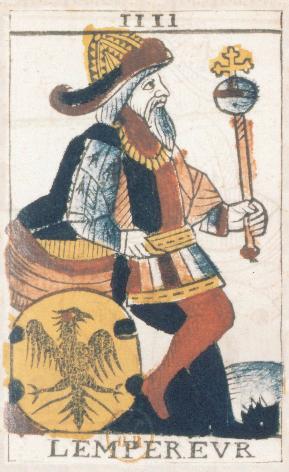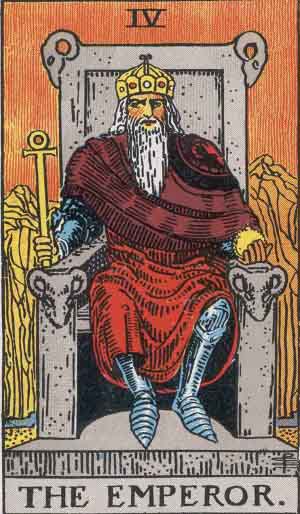Tarot Deep Dive - The Emperor
- Dustin

- Sep 20, 2020
- 5 min read
Updated: Aug 14, 2021
In this series we are going to dive into the history of the imagery found in the tarot, the meaning of the card and how it changed over time, and the symbols present within what is arguably the most well known tarot deck of today - the Rider-Waite (Smith) Tarot Deck. So grab your favorite RWS deck, a cup of tea or coffee, and join me live on Sunday mornings over on YouTube as we Deep Dive into each one of the 21 Major Arcana cards continuing with the enigmatic Emperor.

The King, The Emperor, The Son of the Morning The great and powerful Emperor is an archetype that stretches as farm back in time as civilization itself. From traditional native chieftains, pharaohs, sultanates, kings, and emperors, long have single powerful patriarchal figures ruled over civilizations. It was not until the turn of the 20th century did we see an upheaval within the human psyche to dis-empower these figures as countries great and small underwent revolutions to abolish forms of monarchy, however, many monarchies still exist to this day. The archetype of the Emperor naturally echoes through both history and myth. Figures such as King Arthur, Constantine, Napoleon, and Nero instantly spring to mind. Interestingly enough one of the earliest complete historical decks we have has an entire major arcana comprised of such figures, the Sola Busca. A deck that heavily influenced Pamela Coleman Smith and Arthur Edward Waite in their creation of the Rider Tarot. In the deck we find such characters as Nebuchadnezzar and Gaius Marius, the uncle of Julius Caesar, and Nero. These figures always conjure up ideas of ruler-ship, conquest, war, leadership, and monarchy. All concepts and ideas we can find within the meaning of the card over the course of its history and evolution. Just as with everything in life emperors can be light, or dark, or anywhere in between. Emperors such as Napoleon are villianous, where emperor's like King Arthur bring forth the idea of a just and noble ruler. This duality is a key part of The Emperor card as we see it today. In the end The Emperor is the archetype of male power and patriarchy. A clear product of the time of Tarot's origins.
In our earliest examples of this deck we very much see the tradition similar to the Empress of the traditional Holy Roman Emperor enthroned. This example of The Emperor comes from the Brera-Brambilla version of the Visconti Sforza tarot commissioned by Francesco Sforza in 1463 and is comprised of 48 cards, of witch only two are trumps; The Emperor and The Wheel of Fortune. We see the traditional motifs of the enthroned emperor in the traditional propagandist style which caries forward through time. Symbolically it is important that this type of imagery developed out of propaganda. Each element specifically selected to enhance the elements of masculinity, power, divinity, and right or fitness to rule. In fact, the Emperor card is one of the cards that has seen very little change in imagery and meaning throughout Tarot history. Lets take a look now at how things, changed, or did not change through history.
Evolution of Meaning
De Mellet (1781): The King.
Levi (1855): The Hebrew Deleth, the Emperor. The Porte (the Turkish Sultan's court), or government of the East, initiation, power, the Tetragram, the quaternary, the cubic stone.
Mathers (1888): The Emperor. Realization, effect, development.
Golden Dawn (1896): Son of the Morning, chief among the mighty. Emperor. War, victory, strife, ambition.
Waite (1910): The Emperor. Stability, power, protection, realization, a great person, aid, reason, conviction, authority, and will.
Crowley (1944): This card is attributed to the letter Tzaddi, and it refers to the sign of Aries in the Zodiac. This sign is ruled by Mars, and therein the Sun is exalted. The sign is thus a combination of energy in its most material form with the idea of authority. This figure is the alchemical symbol of Sulphur (see Atu X). Sulphur is the male fiery energy of the Universe, the Rajas of Hindu philosophy. This is the swift creative energy, the initiative of all Being. The power of the Emperor is a generalization of the paternal power; hence such symbols as the Bee and the Fleur- deAys, which are shown on this card. With regard to the quality of this power, it must be noted that it represents sudden, violent, but impermanent activity. If it persists too long, it burns and destroys.
We can see that visually the image of the Emperor has stayed fairly true through history with the exception of Papus who chose to depict his emperor as a Pharaoh. It is interesting to note how the meaning shifted around the late 1700s as the perception of monarchy dramatically shifted. Waite and Crowley then synthesized the historical meanings and iconography into their own decks.
The Symbols
Royal Regalia

The Scepter has long been a phallic symbol of power. The scepter represents the sovereign's temporal power and is associated with good governance. A traditionally symbol that has its roots in the most ancient civilization of Mesopotamia. The scepter in this key is an Ahnk. An ancient Egyptian symbol of life. In his left hand he holds the orb of power, representing his dominion over earth. The world is quite literally in the palm of his hand.

Crown As Cirlot says in his classic dictionary of symbols, "Symbolizes in the vary broadest and deepest sense, the very idea of preeminence." The male figure who wears this crown is therefore above all others.

Ram Heads
These symbols found on the throne symbolize the zodiacal sign Aries which The Emperor embodies. They also represent the Emperor's virility and duty to produce a legacy, lineage, and dynasty.

Landscape The depiction of a wasteland or new land is often debated. It either represents the land conquered and laid waste, or a new land barren and ready to be shaped and conquered. One aspect of this symbol people often miss is the stream of water at the base of the crags that represents the flow of life, and Emperor's preparedness for change.

Ceremonial Armor
Our Emperor wears armor to symbolizes not only his wealth and power, but his preparedness for battle.

White Hair & Beard A subtle symbol often overlooked is The Emperor's white hair showing his age and and most importantly his wisdom. For a wise ruler always knows how to lead his people.
As always, be sure to check out our live discussion on this very topic over on YouTube:
References:
Butler, B. Dictionary of the Tarot. New York: Schocken Books, 1986.
Chang, T. Susan. Tarot Correspondences: Ancient Secrets for Everyday Readers. Llewellyn Pulbications, 2018.
Crowley, Aleister (aleister Crowley). Book of Thoth - (Egyptian Tarot). Red Wheel/Weiser, 2017.
Dean, Liz. The Ultimate Guide to Tarot: a Beginners Guide to the Cards, Spreads, and Revealing the Mystery of the Tarot. Fair Winds Press, 2015.
Fiebig, Johannes, and Evelin Burger. The Ultimate Guide to the Rider Waite Tarot. Llewellyn, 2013.
Katz, Marcus. Secrets of the Waite-Smith Tarot: the True Story of the Worlds Most Popular Tarot: with Previously Unseen Photography & Text from Waite & Smith. Llewellyn Publications, 2015.
Waite, A. E. Pictorial Key to the Tarot. Dover Publications Inc, 2005.
Wen, Benebell. Holistic Tarot. North Atlantic Books, 2015.
Images Sourced From: https://en.wikipedia.org/wiki/Wikipedia:Public_domain_image_resources



















Comments